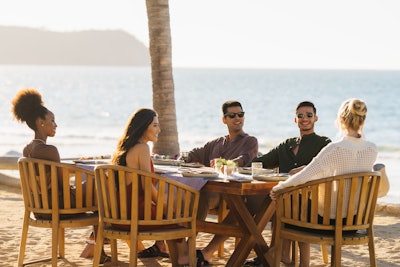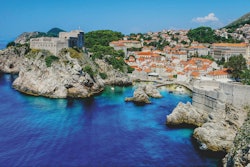
Post pandemic, incentive travel programs are making a big comeback. While they’re still designed to recruit, motivate, and recognize employees, these rewards now need to go above and beyond and prioritize mental, physical, and emotional well-being.
“Incentive travel is expected to be fresh and exciting, with 71% of our respondents indicating an increased demand for new destinations not used before,” Incentive Research Foundation President Stephanie Harris said in a statement, referring to the organization's 2023 Incentive Travel Index results.
“With projected growth and increased demand, incentive professionals will also have to contend with challenges of availability, lift, and access to local resources. The supply chain for incentive travel experiences can be complex, so it’s critical to form strong partnerships with suppliers, including hotels, DMOs, and DMCs,” she continued.
Kate Patay, vice president of engagement for Terramar DMC, a full-service event, destination, conference, and meeting services company, said incentive trips have evolved in recent years—becoming more inclusive (aka open to plus-ones), less structured, and more focused on the local culture. And bleisure continues to be the buzzword, she added, with more travelers extending their stays.
Wondering how to plan an incentive trip that today’s employees will rave about? We polled a few more experts to find out.
Personalize the experience.
Before the journey begins, first find out which activities resonate most with attendees. Conduct surveys before the trip and use the results to curate options for attendees. Allow them to tailor the experience at the destination by offering different activity options and paths like adventure versus relaxation to fit their preferences.
For example, during a recent trip in Lake Tahoe, Terramar offered attendees the option to hit the slopes or enjoy a scenic gondola ride and shop for the non-skiers.
Bobbi Carter, vice president of client services at Dunaj Agency, said planners also need to “provide experiences for the winners and their guests, and to really celebrate both the winner and their guest, as it takes support for that winner to get to where they are.”
Tiffany Cohen, senior vice president of incentives and global sourcing at Opus Agency, said each attendee is motivated by different things. “For some, it’s about the face-to-face time they get with their leadership," she explained. "For others, it’s about sharing the trip with their plus-one. Some are hoping to cross a bucket list destination off their list. And some want to connect with the local culture and immerse themselves in the destination. Ultimately, it’s about reward and recognition. Our challenge is to ensure everyone walks away feeling like their needs have been met.”
Pick the best destination.
Most of the event profs BizBash spoke with agreed that short-hop international flights or easy-to-get-to domestic locations were preferred. Patay said that Cabo, Tulum, Panama, and Napa Valley are popular choices at the moment.
ICYMI: In November, United announced it will offer nonstop flights between the U.S. and the newly opened Tulum International Airport beginning March 31, 2024, so expect that already hot destination to get even hotter.
“If it's a United States-based company, we're going to look for airlift in Hawaii, Caribbean, Mexico, Costa Rica, somewhere there,” Carter said, stressing the need for “easy airlift.” Once the location is determined, she said the property is chosen based on the level of service and experience “that the attendees get that's within the client's budget.”
But what if the client is concerned about safety in a foreign country like Mexico? Sunny Irvine, owner of San Jose del Cabo-based Terramar, said planners need to educate clients “in terms of what their concerns are and what their fears are, and ask them, ‘What's on your mind? What's concerning you? Is it a news article that came out regarding violence somewhere in the interior?’”
Referring to news involving the ongoing cartel wars in Mexico, Irvine said he usually offers a comparison: “Are you going to cancel an event in San Diego because there's a fight in San Francisco?” And because of the negative impact it would have on the country’s tourism infrastructure, ”it's very rare that a tourist gets caught in the crossfire,” he added.
Choose the right partners.
Like any event, it’s the partnerships that can make or break an experience. When choosing a DMC, Carter said the company’s creativeness and flexibility are key “because we are out-of-the-box thinkers, and we don't do the norm.”
Debb Duff, hotel site selection consultant at HelmsBriscoe, stressed the logistical aspects, saying the DMC should own their own vessels if they’ll be transporting the guests.
"I will make sure [the DMC] are boots on the ground in the local community, and not only from a resource perspective, but from a government perspective," said Vince Dreffs of Dreffs For Success, who typically plans events in San Francisco and Las Vegas. “Sometimes we need to access local authorities in order to keep things moving smoothly and safely.”
For example, in August, Dreffs planned an event in Las Vegas, which meant dealing with the city’s construction for the F1 race that took place in November. He said his team agreed to pay $45,000 to have gravel laid for a temporary road for the event’s shuttle system in order to cut 40 minutes of transfer time.
“We would not have been able to do that if we didn't know who could get us in the meetings” in order to allow the temporary road to be built and to make sure it was safe for a 55-passenger bus to travel on it. “It was the foresight of our local partner to say to us, we may want to consider this or we're never going to get these 23,000 people from Grand Garden Arena back to Mandalay Bay.”
 At Conrad de Punta Mita, guests can participate in a temazcal ceremony, a sacred tradition of the Huichol people of western Mexico.Photo: Courtesy of Conrad Punta de Mita
At Conrad de Punta Mita, guests can participate in a temazcal ceremony, a sacred tradition of the Huichol people of western Mexico.Photo: Courtesy of Conrad Punta de Mita
In addition to including greater flexibility and more downtime, today’s itineraries feature more cultural moments and activities. Norma Howard, complex director of group sales for Conrad Punta de Mita, which works with Terramar, said popular experiences at the resort include agave testings and lessons in the Native American culture of Mexico. For example, the hotel offers a temazcal ceremony, a sacred tradition of the Huichol people of western Mexico, as a wellness experience. A local healer guides guests through the journey, which takes place in a dome-shaped earthen chamber heated with stones.
Be mindful of sustainability.
In addition to supporting the local community, planners also need to be aware of their client's objectives when it comes to sustainability and carry those practices throughout the trip.
“I think it's just as much the client's responsibility to provide accurate guarantees as it is the hotel or the venue's responsibility to take care of anything that's left over,” Dreffs said. Instead of overproducing F&B, he explained that his team will ask the facility to provide them with $25 and $50 gift cards that the guests could use at the coffee shop or restaurant should the meals run out that day.
“If we don't create waste, we don't have to deal with waste on the back end,” he said. “You can go back and forth with attendees and get them to choose which meals they're going to attend.” For example, some attendees aren’t breakfast-goers, so there’s no need to include them in the head count.
Cohen said gifting is another area where you can reduce the environmental impact of the incentive program. “This involves ensuring products are sustainably and responsibly made, and exclusively sourcing local gifts that directly benefit the destination.” Plus, attendees don’t want frivolous stuff that takes up suitcase space, so aim for thoughtful swag that commemorates the experience.



















